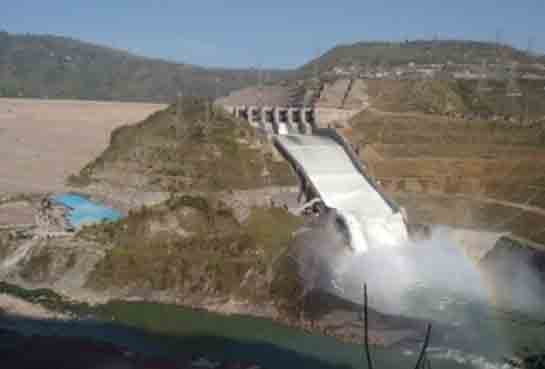SHIMLA: With a vast 40-year experience to his professional kitty, Devendra Kumar Sharma, Chairperson, Himachal Pradesh Electricity Regulatory Commission has been nominated as a specialist member of the National Committee on Dam Safety (NCDS) by the Ministry of Jal Shakti, Government of India for a period of three years.
Ministry of Jal Shakti has constituted NCDS under the Dam Safety Act, 2021 passed by Parliament that now looks after the safety and security and other issues of over major 141 dams all over the country. It was notified in the Gazette of India on 14th December, 2021.
Ministry has issued notification on February 17 to this effect. NCDS has come into force from February 18 across the country. The committee is headed by Chairperson, Central Water Commission (CWC), while Chairperson, National Dam Safety Authority (NDSA) will be a member of this 14-member NCDS.
The appointment of Devendra Kumar Sharma has come as a big moment for Himachal’s engineering and technocratic fraternity as Sharma is a reputed hydropower engineer of the state. Sharma has joined as Chairperson, Himachal Pradesh Electricity Regulatory Commission on 26th September, 2020. He has more than 40-year experience to his professional kitty in energy and water resource sectors in India and abroad.
Not only this, Sharma is also a Member of the National Security Advisory Board in National Security Council, Govt of India. Prior to this, he worked as Chairman, Bhakra Beas Management Board, Ministry of Power, Government of India, from April, 2017 to July, 2020 where he was responsible for managing assets of National Importance, viz, dams and six power houses of having aggregate capacity of 2919 MW and 3705 km long 400 KV and below transmission system. Earlier, he was Managing Director of Himachal Power Corporation Ltd. (a Govt. of Himachal Pradesh Undertaking) from September, 2012 to April, 2017.
He has also worked in Tala Hydroelectric Project Authority in Bhutan for 1020 MW hydroelectric project. He has worked in SJVNL for dam of 1500 MW NathpaJhakri Hydroelectric Project and in HPSEBL in various capacities. He has been responsible for planning, design and construction of number of dams in the country. He is also Vice- President of the International Commission on Large Dams (ICOLD) and the President of the Committee for International Commission on Large Dams, India (INCOLD).
As a matter of fact NCDS has come in its avatar at a time when the "water safety, water security and water quality" have assumed huge significance in the country and all over the world. The water exigencies have been triggered by the depleting water towers, water resources, depleting glaciers and receding rivers and the depleting underground water table and pollution of water bodies across the country. 
Other members of the committee are the Member, Design and Research, CWC, the Central Electricity Authority, Ministry of Power, representative of Water Resources River Development and Ganga Rejuvenation, Ministry of JAL shakti, representative of National Disaster Management Authority, Ministry of Home Affairs, representative of Ministry of Environment Forest and Climate Change. Other members include, Director General India Meteorological Department(IMD), Ministry of Earth Sciences, Director General, Geological survey of India, Director National Geophysical Research Institute, Director National Remote Sensing Center ISRO, Direct general Geo-physical Resource Institute.
NCDS has seven representatives of the State Government, Engineering- in-Chiefs equivalent by rotation, three specialists in the field of dam safety and allied fields. The Member (Policy and Research), NDSA is the Member- Secretary of NCDS.
NCDS takes care of all aspects of safety and security and other issues of dams under CWC. The committee has brought all the major dams under one umbrella committee in view of the security concerns raised by the threat perception from terrorist organizations or insurgents that may target dams that, in turn, can pose danger to downstream communities, power houses and irrigation systems across the country.
From Baglihar, Dulhasti, Kisanganga dams in Jammu and Kashmir to Bhakhra, Pong Dam, Kol Dam, Chamera in Himachal and Tehri, Dhauliganga, Baigul in Uttarkhand, there are over 50 small and big dams on the Himalayan rivers. These dams are backbone of power generation, but they also supply water for irrigation and drinking for the lakhs of population living downstream along the river basins. 
There are over dozen of antique dams and irrigation projects of the like Mulla Periyar Dam, which have earned the prestigious heritage status because of their unique design and antiquity in the country. There are others which have become major sources of fisheries, nesting sites for migratory birds and wild animals, major tourist attraction and water sports that give livelihoods for lakhs of people across the country.
Many state governments and state Power Board have set up the dam safety cells in the state Energy department or boards, but now on the government will have the dedicated body under the NCDS, said the officials.
NCDS will now monitor the control, conservation and utilization of water resources throughout the country which comes under the CWC. CWC oversees control, conservation and utilization of water resources, for purpose of Flood Control, Irrigation, Navigation, Drinking Water Supply and Water Power Development. CWC also undertakes the investigations, construction and execution of any such schemes as required.
(Kuldeep Chauhan is Editor, HimbuMail).




